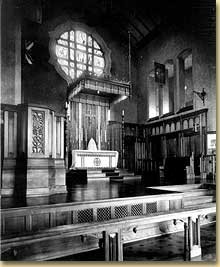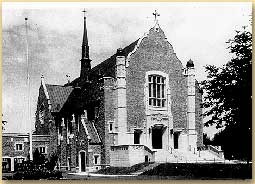There has been a chapel on the west end campus since Loyola College first built there.
In the original Loyola College building plan of 1913, the chapel was intended to be where the Central Building currently stands. Money was in short supply in the early Loyola days and building projects happened as money became available. When the campus first opened in 1916, the student chapel was housed in the east wing basement of the Junior or High School Building (now the Psychology Building). Local residents soon began attending mass in the Loyola chapel, and in 1917 an English Roman Catholic parish was formally established and run by the Jesuits. It was only in the 1930s that the funding was finally available to build a separate chapel building for the College which would also serve as the parish church. The Loyola Rector at that time, Thomas McMahon, S.J., decided not to follow the original campus block design, but to place the chapel facing Sherbrooke Street and the larger community.
The Loyola Chapel building was designed by Architect Henri Labelle, and it fits well with the style of the original Loyola buildings of 1916--the Administration Building, the Refectory, and the Psychology Building (formerly known as the Junior or High School Building). The chapel was blessed and officially opened on April 2, 1933. It was built in memory of Charles Francis Smith and Margaret McNally, the parents of Francis C. Smith, S.J. When Father Smith, a Loyola graduate, took his final vows of poverty in the Jesuit order, some of his family inheritance was put towards the building of the long-awaited Loyola chapel and auditorium. The auditorium was named in his honour after his death. The downstairs auditorium was completed in 1934, followed by the foyer seven years later. The auditorium was the main venue for Loyola productions of various kinds until the Concert Hall was opened in 1990, and it has been a popular west-end site for theatre, film, concerts, and recitals, including a performance by Thelonius Monk.



